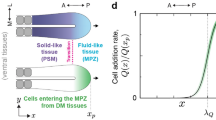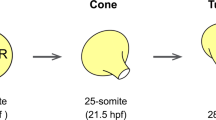Abstract
Substantial insight has recently been achieved into the mechanisms responsible for the generation of left–right (L–R) asymmetry in the vertebrate body plan1,2,3,4. However, the mechanism that underlies the initial breaking of symmetry has remained unclear. In the mouse, a leftward fluid flow on the ventral side of the node caused by the vortical motion of cilia (referred to as nodal flow) is implicated in symmetry breaking5, but direct evidence for the role of this flow has been lacking. Here we describe the development of a system in which mouse embryos are cultured under an artificial fluid flow and with which we have examined how flow affects L–R patterning. An artificial rightward flow that was sufficiently rapid to reverse the intrinsic leftward nodal flow resulted in reversal of situs in wild-type embryos. The artificial flow was also able to direct the situs of mutant mouse embryos with immotile cilia. These results provide the first direct evidence for the role of mechanical fluid flow in L–R patterning.
This is a preview of subscription content, access via your institution
Access options
Subscribe to this journal
Receive 51 print issues and online access
$199.00 per year
only $3.90 per issue
Buy this article
- Purchase on Springer Link
- Instant access to full article PDF
Prices may be subject to local taxes which are calculated during checkout




Similar content being viewed by others
References
Beddington, R. S. & Robertson, E. J. Axis development and early asymmetry in mammals. Cell 96, 195–209 (1999)
Capdevila, J., Vogan, K. J., Tabin, C. J. & Izpisua Belmonte, J. C. Mechanisms of left-right determination in vertebrates. Cell 101, 9–21 (2000)
Wright, C. V. Mechanisms of left-right asymmetry: What's right and what's left? Dev. Cell 1, 179–186 (2001)
Hamada, H., Meno, C., Watanabe, D. & Saijoh, Y. Establishment of vertebrate left-right asymmetry. Nature Rev. Genet. 3, 103–113 (2002)
Nonaka, S. et al. Randomization of left-right asymmetry due to loss of nodal cilia generating leftward flow of extraembryonic fluid in mice lacking KIF3B motor protein. Cell 95, 829–837 (1998)
Sulik, K. et al. Morphogenesis of the murine node and notochordal plate. Dev. Dyn. 201, 260–278 (1994)
Okada, Y. et al. Abnormal nodal flow precedes situs inversus in iv and inv mice. Mol. Cell 4, 459–468 (1999)
Takeda, S. et al. Left-right asymmetry and kinesin superfamily protein KIF3A: new insights in determination of laterality and mesoderm induction by kif3A- / - mice analysis. J. Cell Biol. 145, 825–836 (1999)
Supp, D. M. et al. Targeted deletion of the ATP binding domain of left-right dynein confirms its role in specifying development of left-right asymmetries. Development 126, 5495–5504 (1999)
Pazour, G. J. et al. Chlamydomonas IFT88 and its mouse homologue, polycystic kidney disease gene tg737, are required for assembly of cilia and flagella. J. Cell Biol. 151, 709–718 (2000)
Hogan, B. L. et al. Manipulating The Mouse Embryo: A Laboratory Manual (Cold Spring Harbor Laboratory Press, Cold Spring Harbor, New York, 1994)
Shiratori, H. et al. Two-step regulation of left-right asymmetric expression of Pitx2: Initiation by Nodal signalling and maintenance by Nkx2. Mol. Cell 7, 137–149 (2001)
Collignon, J., Varlet, I. & Robertson, E. J. Relationship between asymmetric nodal expression and the direction of embryonic turning. Nature 381, 155–158 (1996)
Lowe, L. A. et al. Conserved left-right asymmetry of nodal expression and alterations in murine situs inversus. Nature 381, 158–161 (1996)
Meno, C. et al. Left-right asymmetric expression of the TGFβ-family member lefty in mouse embryos. Nature 381, 151–155 (1996)
Meno, C. et al. Two closely-related left-right asymmetrically expressed genes, lefty-1 and lefty-2: their distinct expression domains, chromosomal linkage and direct neuralizing activity in Xenopus embryos. Genes Cells 2, 513–524 (1997)
Fujinaga, M. & Baden, J. M. Critical period of rat development when sidedness of asymmetric body structures is determined. Teratology 44, 453–462 (1991)
Downs, K. M. & Davies, T. Staging of gastrulating mouse embryos by morphological landmarks in the dissecting microscope. Development 118, 1255–1266 (1993)
Acknowledgements
We thank I. Minoura for helpful discussion of hydrodynamics and K. Mochida and other members of the Hamada laboratory for technical help and valuable comments. This work was supported by CREST (Core Research for Evolutional Science and Technology) of the Japan Science and Technology Corporation. S.N. was supported by CREST and by a fellowship from the Japan Society for the Promotion of Science for Japanese Junior Scientists.
Author information
Authors and Affiliations
Corresponding authors
Ethics declarations
Competing interests
The authors declare that they have no competing financial interests.
Rights and permissions
About this article
Cite this article
Nonaka, S., Shiratori, H., Saijoh, Y. et al. Determination of left–right patterning of the mouse embryo by artificial nodal flow. Nature 418, 96–99 (2002). https://doi.org/10.1038/nature00849
Received:
Accepted:
Issue Date:
DOI: https://doi.org/10.1038/nature00849
This article is cited by
-
Structure of putative epidermal sensory receptors in an acoel flatworm, Praesagittifera naikaiensis
Cell and Tissue Research (2024)
-
Primary cilia as dynamic and diverse signalling hubs in development and disease
Nature Reviews Genetics (2023)
-
A change of heart: new roles for cilia in cardiac development and disease
Nature Reviews Cardiology (2022)
-
Fluid flow-induced left-right asymmetric decay of Dand5 mRNA in the mouse embryo requires a Bicc1-Ccr4 RNA degradation complex
Nature Communications (2021)
-
Optical control of cytoplasmic flows
Nature Cell Biology (2018)
Comments
By submitting a comment you agree to abide by our Terms and Community Guidelines. If you find something abusive or that does not comply with our terms or guidelines please flag it as inappropriate.



